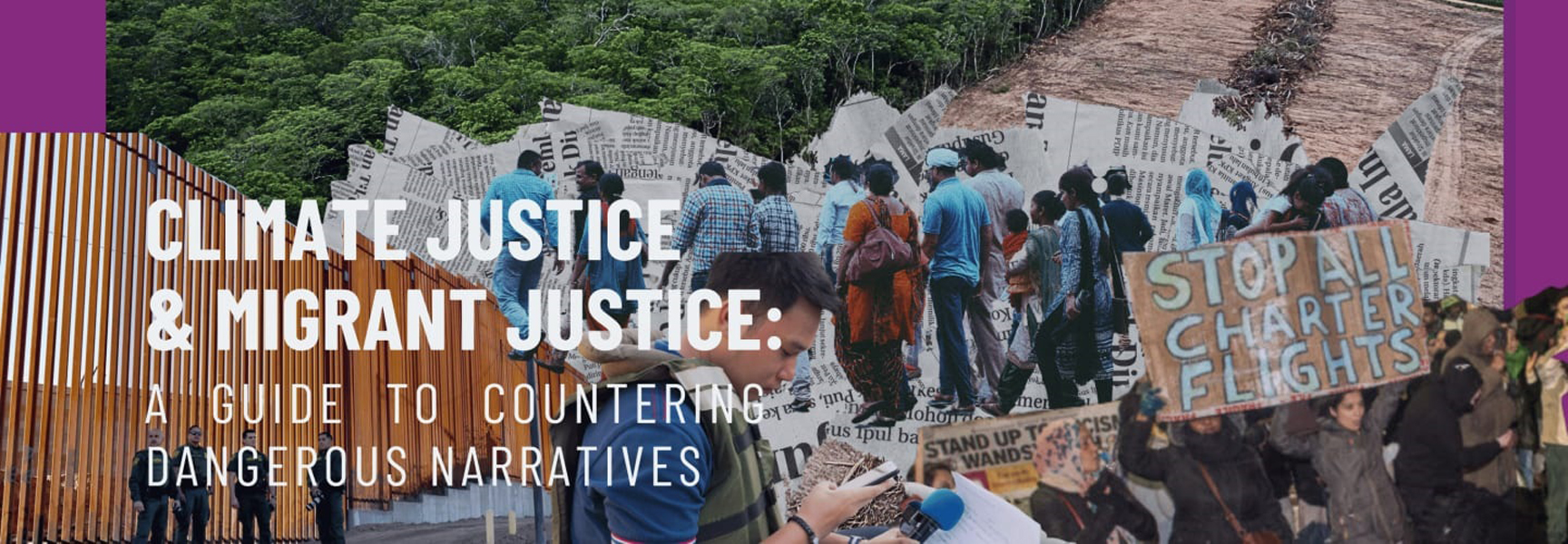
Communicating Migrant Justice
In a world where the effects of climate change are becoming increasingly apparent, the discourse around climate-linked migration is reaching a critical point. Recent narratives, filled with sweeping projections and dangerous undertones, threaten to shape policy responses that lack empathy, compassion and human regard. It’s time we steer this conversation towards a path of solidarity, shared humanity, and justice.
That is why we are excited to share with you our latest brief, ‘Connecting Climate Justice & Migrant Justice: A Guide to Countering Dangerous Narratives’, which we are launching today alongside 350.org, the Climate and Migration Coalition, the Climate Justice Coalition, the Climate Justice Collaborative NPNA, Common Defense, Friends of the Earth US, International Refugee Assistance Project (IRAP), Migrants Organise and Pacific Island Students Fighting Climate Change.
Key highlights of the brief include:
-
1
An in-depth analysis of current narratives:
Understand how the current focus on projected numbers, and the use of dehumanising narratives, are shaping policy responses.
-
2
Naming the real villains:
Learn about profiteers benefiting from the climate crisis and violent borders, and how we can shift the focus onto them, fostering a more just and open approach.
-
3
A vision for the future:
Discover the principles for framing climate and migration, which focus on the right to stay and the right to move, and how they represent real security for communities globally.
It unravels the complex narratives surrounding climate-linked migration. We have the responsibility to craft a narrative that respects the rights of individuals both to remain and to migrate safely and with dignity.
Share the report on Instagram here, or Twitter/X here.
As climate change reshapes global migration patterns, we must emphasise equity and human rights in our approach to climate-linked migration. It is crucial to foster collaboration among movements, media, academics, trade unions, and many more organisations to ensure the dignity and safety of migrants globally.
Dangerous narratives, which often use fear-based language, threaten to undermine this mission by dehumanising migrants and delaying effective climate action. These narratives mask the true complexity of migration and often place undue burden on vulnerable communities. Together, we can counter these narratives through justice-based framing that fosters solidarity, advocates human rights, and propels intersectional climate action.
We are happy to share the guide here to help climate and migrant justice advocates, journalists and policy makers speak about the intersections of climate change and migration.
Addressing the communication gap
Central to the communication challenge is the focus on widely varied estimates of future numbers of people who MAY be forced to flee climate disasters. These large numbers are based on speculation, undermine the right of people to climate adaptation funding and their right to stay in their homes, and serve a dehumanising narrative. The unpredictability of climate disasters and the differing opinions among experts on the best method for data collection make it difficult to accurately project migration trends. This uncertainty fuels polarised debates, often accompanied by the dehumanising portrayal of migrants in headlines and on social media platforms. Inaccurate or exaggerated data can promote dangerous narratives and increase anti-migrant sentiments in communities.
While the majority of climate-related migration happens within nations, cross-border movements also occur. It is essential for communicators to bear in mind that migration is a form of adaptation and that both internal and external movement are key strategies for humane policies in the face of climate disaster and displacement. It’s vital to show solidarity with all affected by climate-related adversities, fostering a ground for fair policy-making that embodies global unity.
Notably, despite its frequent use, the term “climate refugee” isn’t legally recognised. This raises a serious issue: the lack of formal avenues and specific legal frameworks for the support of those forced to move due to climate impacts. The terminology can oversimplify the multifaceted reasons behind individual migration stories, possibly overshadowing the complex conditions driving individuals to relocate. Despite this, some climate migrants might meet the criteria for refugee or asylum status due to other factors influencing their displacement. Hence, precise terminology is essential.
Principles for framing climate and migration
In steering the discourse towards a more humane and compassionate ground, we should promote values that emphasise the innate connection between individuals affected by climate change and their receiving communities. By invoking shared values and highlighting the global nature of climate change, we can foster a narrative that strikes a chord with audiences at a deeper, more empathic level.
Additionally, it is vital to identify and expose those benefiting from the exploitation and ill-treatment of migrants. These range from corporations profiting from border and surveillance industries to fossil fuel enterprises delaying the just transition to cleaner energy sources. By naming these “villains”, the narrative shifts focus onto the real threats, paving the way for the needed policy reforms.
Moreover, the principles of “right to stay” and “right to move” form the cornerstone of a just and visionary approach to climate-linked migration. Advocating for funded climate adaptations and the facilitation of safe, dignified migrations can potentially redefine security for communities worldwide, offering a glimmer of hope and tangible solutions in a rapidly changing environment.
Embracing these principles moves us closer to fostering a narrative that not only recognises the gravity of climate-linked migration but also propels action towards a more inclusive, empathetic, and secure future for all.
For more details, please refer to our briefing, ‘Connecting Climate Justice & Migrant Justice: A Guide to Countering Dangerous Narratives’.
